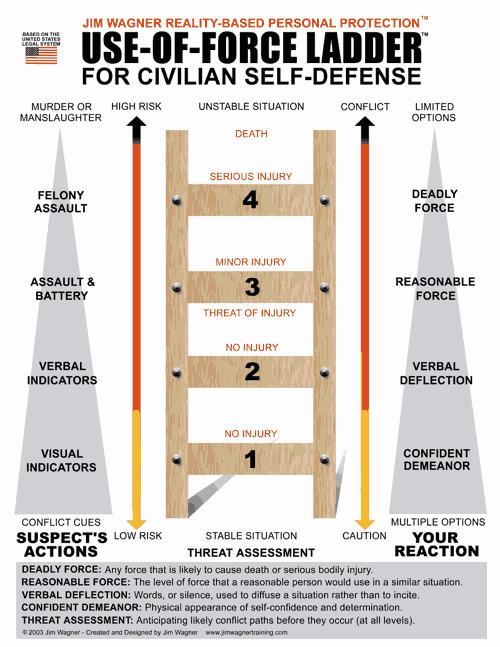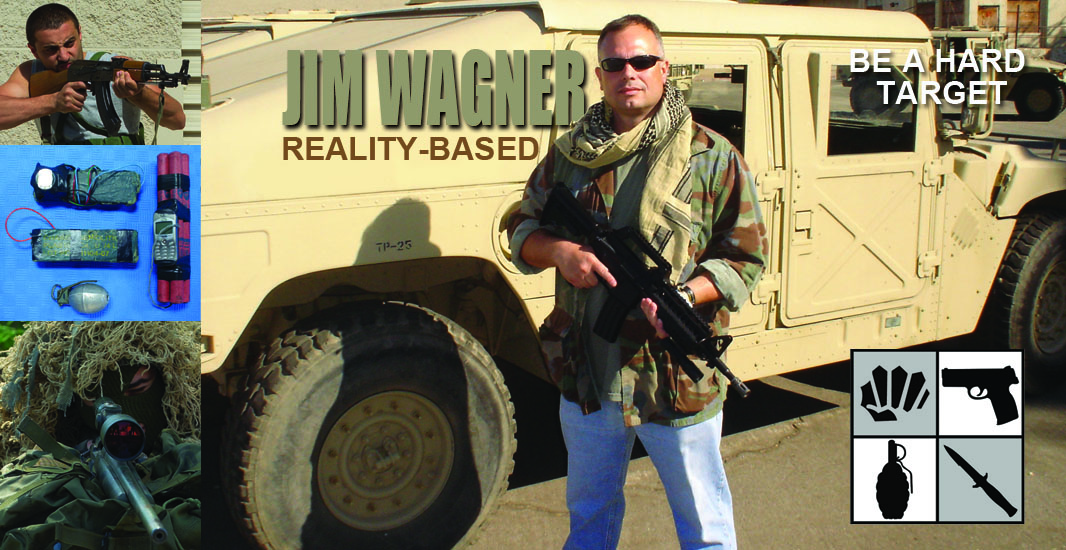Every adversary you come across is going to have the same level of fighting skills and the same reasons for fighting you, right? Wrong. You and I both know that human conflict is unpredictable because there are countless factors involved. Yet, with the way most self-defense instructors teach their students how to handle a fight, one would come to the natural conclusion that there is one generic attacker, and he’s always the worse case scenario bent on your destruction. Yes, there are some predators out there who would not hesitate to victimize anyone they cross paths with, but a “cookie cutter approach,” that is to say a set pattern of self-defense moves, for dealing with conflict can get you hurt and in legal trouble.
Once you actually use your martial arts skills in a real self-defense situation, you will be held legally accountable for your actions. It doesn’t matter if you’re a seasoned street cop or you’ve just completed your third martial arts lesson at the dojo, some prosecutor or defense attorney is going to bring up the use of force issue. They’re going to have a field day with you if you can’t articulate the different levels of force, and what you can and can not do legally at each level. Thus it is imperative that you know what you can and cannot do in any conflict situation.

Download
USA Use of Force Ladder PDF
Canadian Use of Force Ladder PDF
Use of Force Ireland PDF
UK Use of Force Ladder PDF
Based on Standards
I am a former soldier, jailer, street cop, SWAT officer, diplomatic bodyguard, and a federal agent with the U.S. Federal Air Marshal Service, and now currently serving as a Reserve soldier in a military police unit. In every single one of these positions that I have held, I have had to follow a Use-of-Force policy (in the military it is known as Rules of Engagement). If I stayed within the policy, I was protected. If, on the other hand, I acted outside of the policy guidelines (using unreasonable force or violating someone’s legal rights), I could have found myself in jail (with criminal charges) or paying out some big money (in a civil law suit). Fortunately, I have never stepped over that line, even though I have had to use force against suspects and criminals on many occasions.
Being a civilian who is learning personal protection does not isolate you from the law. Ignorance of the laws of the land is not a legal excuse that will protect you against the police or the judicial system, especially when it comes to excessive force cases. Most civilian martial artists have no idea just how much trouble they can get into legally, even when they, in good faith, were just trying to protect themselves or someone else. There are a few well meaning martial artists right now sitting in prison, because they didn’t know where to draw the line, or even where the line was at in the first place when it came to the use of force. This is why I created the Jim Wagner Use-of-Force Ladder for Civilian Self Defense; the first use-of-force continuum graph in martial arts history. Although “the ladder” is similar in concept to what the military and civilian law enforcement agencies must follow, my ladder is specifically designed for civilians, and easy to understand.
The Colors of Conflict
Like a real latter that you would lean up against a building, the most stable place to be is not on the ladder at all. Once you get on, there are risks even from the distance of a few feet (1 meter) off the ground you can get injured. Likewise, in daily life you are always safest when you avoid conflict. Yet, trouble can sometimes find us out without us looking for it.
Before we go up, or down, the ladder you will notice that to the left of the ladder are the subject’s actions (your attacker’s actions), indicated with a gray triangle, and a vertical arrow next to it with a gradient of colors. The arrow corresponds with the Jim Wagner Conflict Color-Code System that I developed, inspired by my military, corrections, and law enforcement, and even my martial arts background:
- Secure (White)
- Caution (Yellow)
- Danger (Orange)
- Conflict (Red)
Secure (White) – is staying off the ladder all together. At this level you are in a secure place: home, work, social events, etc. Conflict is not anticipated. This does not mean that you are totally secure. At Code White you must have emergency plans in place in the event that the peace is disturbed. For example, if you are at home you should have some sort of home security plan: locks, outdoor lighting, alarm system, surveillance cameras, escape routes, etc. At work you must have an escape plan should there be a workplace shooting, and so forth.
Caution (Yellow) – This is the level that you must always maintain when you are in public. You should always be aware of your environment: people, vehicles, behind large objects, dark areas, etc. This is not a state of paranoia, but prudent caution known as Situational Awareness. That’s why the arrow extends below the ladder and into the white area. You should be alert long before you about to get into conflict. Once there is any indication of a conflict the yellow color blends rapidly into orange. On the ladder the yellow turns darker when a subject is giving VISUAL INDICATORS, such a hard stare (mad dogging you), posturing, wearing gang colors, etc.
Danger (Orange) – At this level there is a real possibility of danger since the subject is giving VERBAL INDICATORS: direct threats, suspicious words, etc. The intensity of this Pre-Conflict phase can escalate or dissipate. The potential for conflict can be rapid, steady, or gradual. Although words themselves cannot hurt you physically, words will determine your course of actions. If someone is threatening to hurt you, there must be three elements present before you can take physical action: means (the wherewithal to harm you), opportunity (the immediate ability to harm you), and the intent (the thought to harm you, whether implied [such as a robber with a mask and gun] or verbalized [“I’m going to kill you!”])
Conflict (Red) – At this level you are in physical conflict. Does this mean you can use whatever self-defense techniques you would like? No. There are many levels of conflict. Even in warfare there are differences: low intensity conflict (guerilla warfare, terrorism, etc.) and high intensity conflict (all out war or limited actions). Someone who pushes you because they are rude will not be treated like someone who is trying to stab you with a knife.
Notice that the left arrow of the graph starts at the bottom of the ladder as a low risk situation then escalates to a high risk situation, while the arrow to the right starts from being cautious to being engaged in physical conflict.
The higher you climb any ladder, the more unstable it can become; especially if you are climbing it by yourself. If you are alone when a subject confronts you, you are the only one that can help yourself. Yet, if you have other people with you (strength in numbers) they can help support you. Once you go beyond the ladder you will experience death or injury, just as you would if stepped off a real ladder from the top rung (thus, the top of both arrows are black indicating death or serious injury). In other words, you must always maintain control, no matter what level you are at.
There is good reason why the two arrows in the graph both point upward, and downward. That’s because a conflict situation may start at any level, at any time. You may find yourself in Code Red without going through all of the previous rungs first. For example: if you’re standing in a bank and then suddenly bank robbers barge in blasting away with their guns you’re there in Red zone instantly.
In some situations you may climb the ladder progressively, which is escalation, and in other situations what my have started off high gives way to opportunities to deescalate.
Climbing the Ladder
The Jim Wagner Reality-Based Personal Protection Use-of-Force Ladder has four rungs to make use-of-force levels easy to remember. Police officers often complain that their own Use-of-Force Continuum graphs, or “steps” as they are often called, are difficult to remember. You won’t have that problem with this one. This ladder will be easy to remember in any conflict situation.
Rung 1, or Level 1, starts at the base of stability and ends at Rung 4 which is an unstable and unpredictable height. Remember this rule: The suspect’s actions will always dictate your actions. A true martial artist stays off the ladder if he or she can help it. Avoiding conflict is always the ideal situation. Yet, when you do come face to face with hostile subjects, you may have no choice but to take some action. As we all know, there are three reactions humans will take in a conflict situation: 1. Flight (get away) 2. Fight (defend yourself) 3. Submit (give into the subject’s demands or actions).
Level 1
At level 1 a subject uses VISUAL INDICATORS. In other words, you will feel that there is possible danger based on things that you see: a suspicious subject approaching you, somebody who is looking around nervously, a car slowing next to you. At that moment no laws are being broken by the subject, none that you may be aware of, but you know something is wrong, so you prepare yourself mentally for all possibilities. First you take on a CONFIDENT DEMEANOR (see YOUR REACTION under the right gray triangle). This means that you look confident and not afraid. Your facial expressions indicate that you are aware of your environment and know how to use it to your advantage. CONFIDENT DEMEANOR also means that you look like you are prepared for an encounter or open or you are aware of the danger and you are making a “tactical retreat.”
Level 2
At level 2 things start to heat up. The subject is actively engaging you or others around you, through VERBAL INDICATORS. This can be anything that warns you that an attack is about to happen, but short of direct threats. The conflict cues can be anything from the subject’s tone of voice to implied threats, or even things you overhear such as suspicious passengers in an airplane whispering about how “this is going to be a short flight.” Those are not alarming words in and of themselves, but with some visual indicators one might suspect a possible terrorist attack. If a subject is trying to start a fight with you the best thing to do is to try to calm that person down or ignore them altogether. This is known as VERBAL DEFLECTION. By reacting in this matter you will not incite the situation any further. However, in some situations you may have to use a firm, confident voice to talk some subjects down. You may have no choice but to try to intimidate them, and try to resolve the conflict in this manner. Words will not hurt you physically, but words will be a good indicator that it may escalate to a physical confrontation.
Level 3
At Level 3 we enter into actual physical contact with the subject or multiple subjects. It may be a precursor push, or a punch to the nose, or it could even be a sexual touch (sexual battery). It’s at this level where most martial arts systems teach the cookie cutter approach. If someone simply pushes you to intimidate you or to get you to swing first you cannot launch a side kick and blow their knee out, then come crashing down on them with a drop knee to their spine. If you do, even though you have a right to defend yourself, you would most likely going to jail. This would be “unreasonable force” for the situation.
At Level 3 you can get injured: a broken nose, cuts, bruises, scrapes, soreness, etc., but they are neither serious or life threatening. If the subject throws a few swings at you because you’re throwing him out of your party, you can’t rip his head off the law won’t allow you to do that, even if you did sustain minor injuries from his blows. Because there are not hard and fast rules on what you can and cannot do in a self-defense situation, the law will judge you by a simple rule: What would a reasonable person do in the same situation? The cop who questions you knows what is reasonable or not, and the jury who listens to you will determine what is reasonable or not. By the way, cops are not judged by what a “reasonable person” would do in the same situation, but rather, what a “reasonable peace officer” would do, because they are bound by a lot of restrictions that civilians are not.
Level 4
At level 4 death or serious bodily injury is likely to result, whether the suspect’s, or yours, or someone you are trying to protect. If a suspect does attack you where death or serious bodily injury is likely to result (FELONY ASSAULT for United States law), then you have the right as a citizen to use DEADLY FORCE. This not only applies to felony assaults against you, but those you choose to protect. If someone is trying to harm a family member or co-worker in your presence, you may (but are not required to) use deadly force. However, if the case goes to court, you will still be judged based on reasonableness of the force.
Examples of felony assault include attempted murder, mayhem (putting out an eye, severing a limb, ripping off an ear, etc.), rape, caustic chemical attack, robbery, etc. In other words, and remember these words carefully, you must have fear for your life, or the life of another.
Notice that the gray triangles start off with broad bases, then taper off to mere points. The right triangle represents the options you have in a conflict situation. When we start off with Level 1, there are multiple options: you can walk away, call the police, yell for help, etc. However, by the time you are engaged in a life-and-death conflict there are limited options. If someone is trying to stab you, you have basically one option control the weapon. If you don’t block the knife or grab the hand that controls it, you could be dead.
Memorize it, Use it
On a real ladder you do not always have to go up the ladder rung by rung. If you choose to skip a rung, you can. However, by doing so, it is always more unstable. In a real conflict you may have to skip a level. For example, let’s say that you have a VISUAL INDICATOR that a man has a belt bomb strapped to himself (a very real possibility in this day and age of terrorism). Although one may not truly know the intention of the person (it could be a prank for all anyone knows), the “bomb” itself implies intent to blow himself up, and anything around him. Thus, you can go directly from VERBAL INDICATOR to DEADLY FORCE skipping REASONABLE FORCE altogether based upon what you observed.
By memorizing the Use-of-Force Ladder that I created, you, and those you train with, will be able to stay within the law if you ever have to use your self-defense skills. If you’re a reality-based instructor you can start teaching your students the different levels of force and how they can apply the techniques you have taught them to each level. By doing this, you not only teach them that there is no such thing as a generic attacker, but how to survive the justice system when they use what you have taught them.
I have included a free download of the Jim Wagner Use-of-Force Ladder for your own personal use. You may use this copyrighted graph, as long as it is used in its entirety and no modifications are made to it, for teaching private lessons and group lessons within a legally recognized self-defense school. Any other use requires written permission. The downloads I am making available to you in English are for the United States, Canada, the United Kingdom, and Ireland.
Be A Hard Target.






